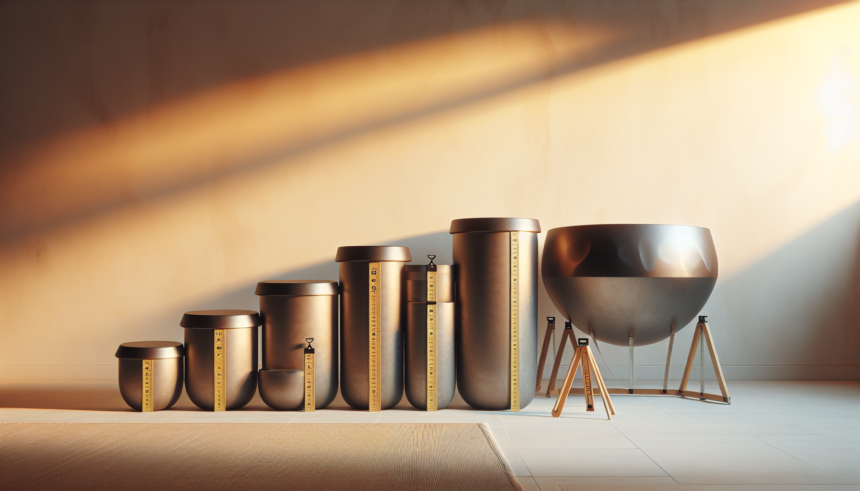The handpan is a relatively new musical instrument that has captivated the hearts of musicians and listeners alike. Known for its ethereal, meditative sound, the handpan offers a unique musical experience. However, choosing the right handpan size can be daunting for newcomers and even experienced musicians. This comprehensive guide aims to help you navigate the world of handpan sizes and find the one that best suits your needs.
Understanding the Basics of Handpan Sizes
Handpans come in various sizes, and the size of a handpan significantly influences its sound, playability, and portability. The most common sizes range from small (around 18 inches in diameter) to large (about 24 inches in diameter). Each size has its own set of characteristics, so understanding the pros and cons of each can help you make an informed decision.
Small Handpans (18-20 inches)
Sound Characteristics
Small handpans generally have a higher pitch and a brighter sound. They are often favored by musicians who prefer a more sparkling, ethereal tone. The notes on a smaller handpan are closer together, which can be advantageous for players with smaller hands or those who want to perform faster, more intricate rhythms.
Playability
One of the key benefits of smaller handpans is their ease of playability. The compact size allows for swift transitions between notes and makes them more accessible to beginners. The smaller distance between notes also makes it easier to perform complex sequences without requiring significant hand movement.
Portability
If you plan to travel with your handpan or take it to multiple locations for performances, a small handpan is an excellent choice. Lightweight and easy to carry, these handpans fit comfortably in standard bags or cases, making transportation a breeze.
Cons
However, the smaller diameter limits the number of notes that can be included, which may restrict your musical range. Additionally, the higher pitch might not resonate with everyone and could be less versatile for various musical genres.
Medium Handpans (21-23 inches)
Sound Characteristics
Medium-sized handpans strike a balance between high and low tones. They offer a rich, full-bodied sound that can accommodate a wide range of musical styles. The notes are still relatively close, but the slightly larger diameter allows for more notes, giving you a broader tonal palette to work with.
Playability
These handpans are comfortable to play for both beginners and experienced musicians. The layout is ergonomic, providing a comfortable reach between notes while still allowing for fluid playability. Medium handpans offer a versatile option that can adapt to various playing styles and techniques.
Portability
While not as portable as smaller handpans, medium-sized handpans are still relatively easy to transport. They may require a specialized case or bag for safe transportation, but they are not overly cumbersome. If occasional mobility is a concern, a medium-sized handpan is a practical choice.
Cons
The main downside of medium handpans is that they might not offer the extreme highs of the smallest sizes or the profound lows of the largest ones. This middle ground might be seen as a compromise for those who have a specific sound in mind.
Large Handpans (24 inches and above)
Sound Characteristics
Large handpans are celebrated for their deep, resonant tones. They produce a rich, warm sound that is well-suited for meditative music and genres requiring lower pitches. The broader surface area allows for a greater number of notes, enabling more complex musical compositions.
Playability
While large handpans offer extensive musical possibilities, their size can make them more challenging to play, especially for beginners. The notes are spread farther apart, requiring more hand movement and precise coordination. However, experienced musicians often appreciate the expansive tonal range and the creative freedom that large handpans provide.
Portability
Portability is the biggest drawback of large handpans. They are heavier and bulkier, making transportation more difficult. Specialized cases are often necessary to protect the instrument during travel. If you plan to perform or practice in a fixed location, a large handpan can be an excellent choice, but it may not be suitable for musicians on the move.
Cons
The size and weight of large handpans can be a limiting factor for some musicians. Additionally, they tend to be more expensive, and their expansive low-end might not suit every musical style or preference.
Choosing the Right Handpan for You
Assess Your Musical Goals
Consider what you hope to achieve with your handpan. Are you looking for a portable instrument to accompany you on your travels, or do you want a handpan with a rich, resonant tone for studio recordings? Identifying your primary use will help you narrow down your options.
Consider Your Skill Level
Your experience and skill level play a crucial role in choosing the right handpan. Beginners might find smaller handpans easier to learn, while experienced players might prefer the broader tonal range of larger handpans. If possible, try out different sizes to see which one feels most comfortable to you.
Think About Your Playing Environment
If you primarily play in a studio or a fixed location, the size and weight of the handpan might not be a significant concern. However, if you often perform in different venues or enjoy playing outdoors, a smaller, more portable handpan may be more suitable.
Budget Considerations
Handpans can be a significant investment, and prices vary based on size, quality, and craftsmanship. Determine your budget beforehand and choose a handpan that offers the best balance of quality and affordability for you.
Personal Preference
Ultimately, choosing the right handpan comes down to personal preference. Listen to various handpans, pay attention to how they sound and feel, and trust your instincts. The right handpan should resonate with you both musically and emotionally.
Conclusion
Finding the perfect handpan size involves a blend of practical considerations and personal preferences. Small, medium, and large handpans each offer unique advantages and potential drawbacks. By assessing your musical goals, skill level, playing environment, and budget, you can make an informed decision. Remember that the right handpan for you is the one that inspires you and enhances your musical journey.
Frequently Asked Questions (FAQs)
1. What is the ideal handpan size for a beginner?
For beginners, a small to medium-sized handpan (18-23 inches) is often recommended. These sizes are easier to play, more accessible, and generally offer a good balance between portability and tonal range.
2. How many notes can a handpan have?
The number of notes on a handpan varies based on its size and design. Smaller handpans may have around 7-9 notes, while larger ones can have 10-15 or more. The number of notes influences the musical range and complexity of the instrument.
3. Can I travel with a large handpan?
While traveling with a large handpan is possible, it can be challenging due to its size and weight. Specialized cases are often required to protect the instrument during transportation. If portability is a priority, a smaller handpan might be more convenient.
4. Do larger handpans sound better?
The sound quality of a handpan is subjective and depends on personal preference. Larger handpans offer a deeper, resonant tone, while smaller ones have a brighter, higher pitch. The “best” sound varies from musician to musician, so it’s essential to try different sizes and see which one resonates with you.
5. Are handpans expensive?
Handpans can be quite expensive, with prices ranging from a few hundred to several thousand dollars, depending on size, quality, and craftsmanship. It’s crucial to set a budget and choose a handpan that offers good value for the price.





